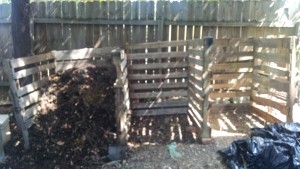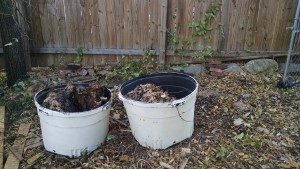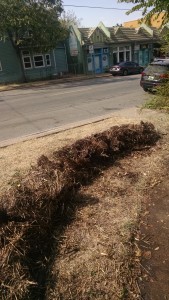We’ve been busy here at the urban homestead….
First, we salvaged several pallets to start a measured compost pile. Now, there are many ways of composting – from piling some vegetable matter in a heap and walking away … for as much as a year. After all everything composts eventually. All the way to the 18-day Berkeley method that requires careful building and turning religiously throughout the 18-day period.
I chose to go with a medium-time way. Pallet-walled bins that allow turning on an occasional basis. We’ll have compost within a month or so. In fact, much of the vegetable matter that went into the bin were composting of themselves in the plastic bags! With the chicken-coop litter, nitrogen was incorporated to help heat the pile up. Made sure it was damp and then covered it with a tarp.
It was great to have the bins made…I’d been using old tree-planters and before that a little galvanized can. The bin method will suit me, because I’ve been expanding my planting areas in the front yard and will need a bunch of compost to complete it.
We cleared the backyard of downed and cut branches and sticks and put them on the street for the bulk pickup. But THEN…. we decided to start another growing bed – in the ground, actually, rather than in a container (!). So we took the pile down by half by laying out the sticks and branches to form a narrow, curving bed to follow the walkway in a portion of the front yard.
Then, because my straw bales had seen better days for growing (after all, they had survived two seasons!), they went on top of the sticks, mixed in with some leaves I begged off the landscapers at my bank.
Next, we’ll put more vegetable matter on the bed, then top it all off with mulch and plant.
This type of bed is called “hugelkultur” which is a technique that has been used in Eastern Europe for centuries. (See my earlier postings on hugelkultur – they are more detailed.) BUT….the essential thing about this technique is that it retains water. That’s what we need in dry times, like we’re having now. As the wood on the bottom decomposes, not only does it serve as a habitat for fungi, particularly mycorrhizal fungi (which are so important for the soil food web), but the wood becomes like a sponge and holds water.
Remember this – if nothing else – the more organic matter we can put into the soil, the more water it will hold when it rains, and the less you will have to water your plants!





